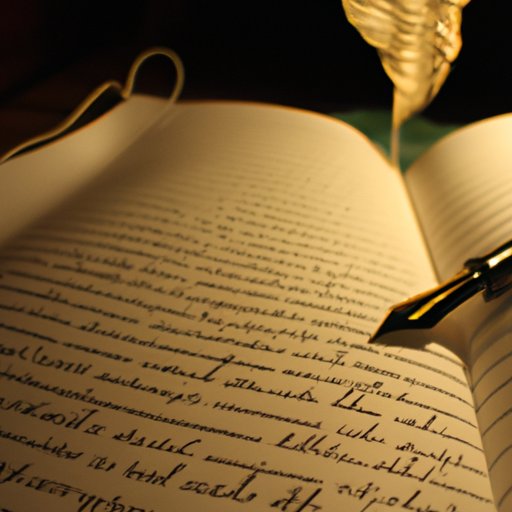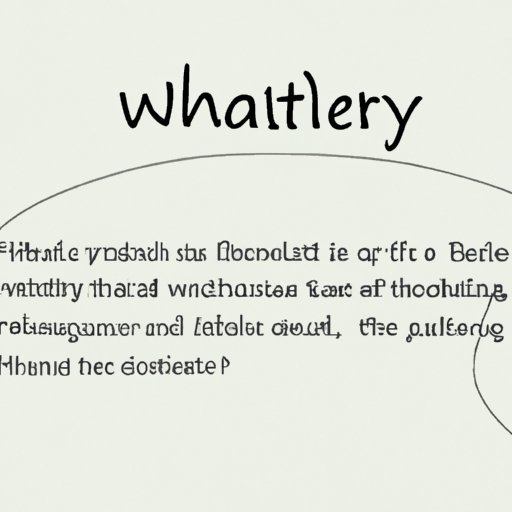Introduction
Literary writing is a form of art that uses language as its medium. It can be found in books, newspapers, magazines, plays, films, and other forms of media. Its purpose is to entertain, educate, inspire, and persuade the reader or viewer. While it can take many forms, all literary writing has certain elements in common, such as characterization, setting, plot, theme, and style.
Analyzing the Different Types of Literary Writing
Literary writing can be divided into four main categories: fiction, non-fiction, poetry, and drama. Each category has its own distinct characteristics and conventions.
Fiction
Fiction is a type of narrative literature that is not based on fact. It includes stories, novels, novellas, short stories, and other works of imaginative writing. Fiction often deals with abstract concepts such as love, death, and justice, and often features characters that are larger than life. It can be set in any time period or place, and can range from lighthearted to dark and serious.
Non-Fiction
Non-fiction is a type of writing that is based on facts. It includes biographies, autobiographies, essays, memoirs, and other works of factual writing. Non-fiction often deals with real people, places, and events, and can range from lighthearted to dark and serious. It is usually written in a straightforward manner, without the use of literary devices.
Poetry
Poetry is a type of literature that uses words to create images and express emotions. It often employs figurative language, such as metaphor and simile, to evoke vivid mental images. Poems can be long or short, serious or humorous, and can range from the simple to the complex. They can be written in any form, from free verse to traditional rhyming schemes.
Drama
Drama is a type of literary writing that is meant to be performed. It includes plays, musicals, operas, and other works of theatrical writing. Drama often features larger-than-life characters and plots that revolve around conflict and resolution. It is usually written in dialogue form, with each character’s lines separated by stage directions.

Exploring the Elements of Literary Writing
All forms of literary writing share certain elements, which work together to create a unified whole. These elements include characterization, setting, plot, theme, and style.
Characterization
Characterization is the process of creating characters in a story. It involves giving characters names, physical descriptions, personalities, motivations, and backstories. Characters can be dynamic (changing over the course of the story) or static (remaining the same). They can also be protagonists (the “good guys”) or antagonists (the “bad guys”).
Setting
Setting is the time and place in which a story takes place. It can be an actual place, such as London in the 19th century, or a fictional place, such as Middle Earth in The Lord of the Rings. Setting affects the mood and tone of a story, as well as the actions and decisions of the characters.
Plot
Plot is the sequence of events that make up a story. It includes the introduction of the characters and setting, the rising action, the climax, the falling action, and the resolution. Plot is usually driven by conflicts between characters or within the protagonist’s mind or heart.
Theme
Theme is the central idea or message of a story. It is often expressed through symbols, motifs, and imagery. Common themes in literature include love, death, justice, and power. A story’s theme can be subtle or overt, but it should always be clear to the reader.
Style
Style is the way in which a story is told. It includes the use of figurative language, sentence structure, and word choice. Style can be formal or informal, poetic or prosaic, and can vary depending on the author’s voice and intended audience.

Understanding the Purpose of Literary Writing
The purpose of literary writing is to entertain, educate, inspire, and persuade the reader or viewer. It can be used to explore difficult topics such as racism, sexism, and war, or to simply provide an escape from the everyday. It can make us laugh, cry, think, and feel. No matter what its purpose, literary writing should always strive to move the reader emotionally and intellectually.

Looking at Popular Examples of Literary Writing
Some of the most famous examples of literary writing come from classic authors such as William Shakespeare, J.K. Rowling, Jane Austen, and Ernest Hemingway. Each of these authors has created timeless works that have inspired generations of readers. Their works are still widely read today, and serve as examples of how powerful and influential literary writing can be.
Examining How Literary Writing Has Evolved Over Time
Literary writing has changed significantly over the centuries. The rise of genre fiction, the influence of technology, and the impact of social change have all played a role in shaping the way we write and read today. From ancient myths to modern blockbusters, literary writing continues to evolve in order to meet the changing needs of its audience.
Discovering How to Use Literary Writing in Your Own Work
If you want to use literary writing in your own work, it is important to understand the elements of literary writing and the purpose of literary writing. You must create interesting characters, choose a setting that fits your story, craft a plot that moves the story forward, develop themes that resonate with your audience, and establish a style that is unique to you. By understanding the basics of literary writing, you will be able to create stories that will captivate and move your readers.
Conclusion
In this article, we explored what literary writing is and how it can be used. We looked at different types of literary writing, the elements of literary writing, the purpose of literary writing, popular examples of literary writing, and how literary writing has evolved over time. By understanding the basics of literary writing, you can create stories that will captivate and move your readers.
(Note: Is this article not meeting your expectations? Do you have knowledge or insights to share? Unlock new opportunities and expand your reach by joining our authors team. Click Registration to join us and share your expertise with our readers.)
